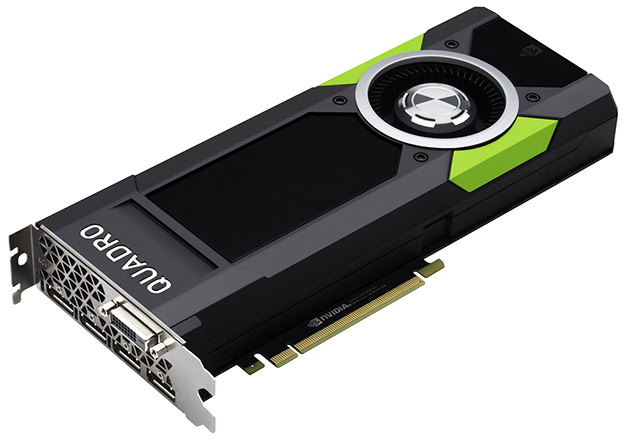NVIDIA Quadro P6000 and P5000 Professional Graphics Cards – Review and Testing | Power Supply and CPU Performance: NVIDIA Pascal architecture is no longer a novelty: the first products based on it in the form of Tesla computing accelerators and GeForce GTX gaming graphics cards of the thousandth series appeared on the market in spring 2016. And it is quite natural that over time, the most modern generation of graphics processors reached the Quadro line.
Introduction – NVIDIA Quadro P6000 VS P5000
which brings together accelerators for workstations. Formally, they were announced six months ago, at the SIGGRAPH 2016 conference, but in reality, the path of new professional graphics solutions to the market turned out to be not so fast due to the need to optimize software and certify accelerators from the developers of engineering packages. As a result, the real appearance of new Quadro cards, built on GPUs of the Pascal family, took place only now. And if so, then it’s time to get acquainted in detail with those possibilities, which they offer. About six months ago, wetested the entire line of modern Quadro graphics accelerators in detail , but the most recent representatives back then were based on the Maxwell 2 architecture. Now it’s time to see how much progress has made in the field of professional graphics in recent years.
In terms of professional graphics solutions, NVIDIA is trying to maintain a not too intensive schedule of updates for flagship products. New versions of high-performance workstation graphics cards are released every two years on average. But to say that someone loses a lot from such a measured pace would be completely wrong. Of course, one can think that the constant changes of leaders in the Quadro line do not occur due to the fact that NVIDIA was able to occupy an almost monopoly position in the market of graphics accelerators for engineering applications. And most likely, such argumentation also has some meaning. But another motive plays a more important role here: the flagship cards of the Quadro family are very expensive products, so their buyers need investment protection, and pushing them to upgrade their systems frequently is not the right approach, which is unlikely to awaken their loyalty. Therefore, it is not surprising that the past flagship acceleratorThe Quadro M6000 , which belongs to the Maxwell 2 generation, entered the market in early 2015 and has consistently remained the top choice for 3D modeling and CAD systems ever since. True, in early 2016, in response to the appearance of the AMD FirePro W9100, it was cosmetically updated with the addition of video memory, but NVIDIA has released something fundamentally better for workstations – the new Quadro P6000 accelerator – just now.
The pursuit of high performance in the field of professional accelerators is gradually losing its meaning for another reason. The fact is that the load created by CAD / CAM systems in the projection windows is not so high in order to reveal the lack of performance even in video cards of a level closer to the average. Our tests show that Quadro M4000 accelerators show optimal performance in 3D modeling and computer-aided design systems. More powerful video cards may be needed only when working with very complex highly detailed models, which are rarely found in real life. And this situation does not change either with the release of new versions of software packages, or with the transition to 4K resolutions, or with the inclusion of anti-aliasing.
The working environment of CAD / CAM systems generates a relatively simple graphic workload, the essence of which, in fact, boils down to elementary geometric transformations, the imposition of simple textures and the use of simple lighting models. Of course, we are almost never talking about any shader operations or any post-processing. Therefore, many professional engineers simply have no incentive to upgrade their systems and migrate to new flagship accelerators.

Nevertheless, NVIDIA is quite effectively fighting the latest trend, opening up new areas of application for the high-performance Quadro graphics accelerators discussed in this article. Today’s Quadro is no longer a simple hardware tool for increasing the comfort when working in the projection windows of CAD / CAM systems.
Now these accelerators are ready to take on the tasks of final rendering, mathematical modeling, and even creation and processing of multimedia content. In other words, modern professional Quadro accelerators are no longer just highly specialized video cards. Today they claim to be a far more versatile work tool for engineers, designers, modelers or editors.
NVIDIA Quadro P6000 and P5000 in Detail
While with gaming video cards NVIDIA is trying to carry out the change of architecture generations in all price segments in a fairly tight timeframe, in terms of professional accelerators the company adheres to the opposite strategy. So far, NVIDIA has started selling only two Pascal-based Quadro accelerators.
It is the flagship model P6000 and the sub-flagship of the P5000, which replace the predecessors Quadro M6000 and M5000. Cheaper professional video cards are still based on Maxwell generation processors. Moreover, this situation will continue for at least a couple of months. Although NVIDIA has already announced the junior Pascal-based Quadro, they are not yet available for sale.

And the reasons for this approach are well understood. The transition from Maxwell to Pascal brings with it a very noticeable performance increase, so the introduction of a new GPU in mid-range accelerators will instantly “devalue” video cards, which until recently were considered the best professional accelerators. With flagships, it’s easier – the significant performance gains in the P6000 and P5000 only bring the Quadro M6000 and M5000 to a lower level, but do not make them categorically obsolete and meaningless. To assess how much higher potential new items have, you can from the following table, in which we compared their characteristics with those of their predecessors.

So, the fastest graphics card for graphics workstations so far is the Quadro P6000. It is based on the GP102 processor, the most powerful Pascal variant of the GDDR5X memory chips. It is this GPU, and not the “supercomputer” GP100, that should be considered a direct descendant of the GM200 processor used at the heart of the Quadro M6000. Therefore, it is not surprising that in comparison with the previous flagship professional accelerator, the Quadro P6000 video card has significantly increased its computing power: the number of CUDA cores has grown by a quarter.
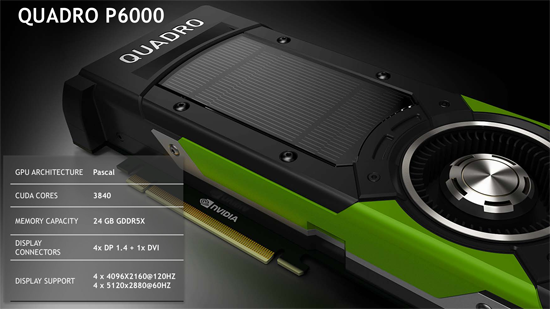
This amplification made the Quadro P6000 the fastest graphics card, not only by the standards of professional solutions. For the first time, a Quadro solution is even more powerful than the TITAN X. The P6000 uses the GP102 processor to its fullest, and all 30 streaming multiprocessors in the architecture are enabled in it. As a reminder, TITAN X has only 28 active multiprocessors, and for this reason it is somewhat weaker than the professional flagship.

The Quadro P6000 also looks advantageous in terms of memory capacity. The video card is equipped with 24 GB GDDR5X SDRAM, operating at a fairly conservative effective frequency of 9 megatransfers per second, which, given a 384-bit bus, gives a total bandwidth of 432 GB / s. Compared to the updated version of the Quadro M6000, the memory capacity remains the same, but its speed has significantly increased due to the use of GDDR5X. Moreover, the 24 GB version of the M6000 appeared on the market relatively recently, and the number of owners of such a card is not so high. A more massive variation of this card was content with 12 GB of memory, so most owners of powerful workstations, when switching to Quadro P6000, will receive not only an increase in performance indicators, but also increased memory. which can be useful when working with large-scale digital projects of machines and mechanisms. As before, the memory in the Quadro P6000 supports ECC, and since the GDDR5X chips themselves do not support error correction, this is a software and driver-activated feature.

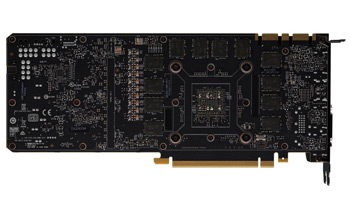
It is noteworthy that the unprecedented performance of the new professional flagship is combined with rather moderate energy appetites. The passport value of the thermal package Quadro P6000 is set in the traditional for cards of this level 250 W, and the cooling system, which includes a radiator closed with a metal casing and a centrifugal fan, is completely borrowed from the M6000. What’s more, the P6000 manages to get by with a single 8-pin power connector. This is somewhat at odds with the specifications (formally, the 8-pin connector is designed for 150 W of power, and up to 75 W can be supplied through the PCIe x16 slot), but in real use there are no problems with the video card. But full backward compatibility is achieved: in a workstation where the Quadro M6000 was used, it will not be difficult to replace it with a new P6000.
Since NVIDIA claims that the calculated performance of the Quadro P6000 on 32-bit operations exceeds 12 Teraflops, we can conclude that the new flagship is 80 percent more powerful than its predecessor in terms of computing, while the superiority in rasterization speed is only about 48 percent. The advantage of the Quadro P6000 over the TITAN X is also impressive: the gaming flagship has a peak FP32 performance of only 11 teraflops.
True, such a rosy performance of the peak theoretical performance is somewhat darkened by the situation with the execution speed of 16- and 64-bit operations. Each shader multiprocessor of the GP102 chip with 128 CUDA cores for FP32 operations has only 4 cores for FP64. This means that the performance of the Quadro P6000 when working with double precision numbers corresponds to the speed of single precision operations as 1:32. Here, in comparison with the Quadro M6000, no changes have occurred, which means that the oldest Quadro K6000 remains the fastest video card of the Quadro series for 64-bit computing. The Quadro P6000 also lacks FP16 half-precision acceleration. Only one of the CUDA cores of each shader multiprocessor supports such operations in hardware, so the GP102 chip executes them 64 times slower than FP32 instructions. And that means that for complex physical calculations the Quadro series cards are poorly suited, this is just a graphics accelerator, in which support for FP16 and FP64 was introduced only for compatibility. However, do not forget about the specialized Tesla P100 accelerators: it is they, and not Quadro, that are positioned by NVIDIA as topical solutions for supercomputer applications, and now everything is in order with the speed of FP16 and FP64 operations.
Together with the flagship Quadro P6000, the company has released the second simpler professional graphics accelerator – Quadro P5000. And while the P6000 is the fastest graphics card available today, the P5000 is the more mainstream and cheaper alternative. The actual cost of the P6000 is about $ 5400, while the P5000, which has the same modern Pascal architecture, can be purchased for more than half the price – for about $ 2500. However, such a radical difference in price did not arise out of nowhere. While the Quadro P6000 is the flagship fully unlocked GP102 graphics card that outperforms the TITAN X, the P5000 is just a professional version of the GeForce GTX 1080 based on the simpler GP104 GPU.

The Quadro P5000 uses the full version of the GP104 GPU, which means that this video card can offer the user 20 shader multiprocessors or 2560 CUDA cores – a quarter more than the Quadro M5000. However, the main trump card of this professional video card is not an extensive increase in the number of CUDA cores. Just as in the case of other products of the Pascal generation, the transition in the production of GPUs to the 16nm process technology allowed NVIDIA to dramatically increase the clock frequencies. As a result, in terms of peak processing power, the Quadro P5000 outperforms the previous card of the same class, the M5000, more than twice, and the superiority of the new product in rasterization speed reaches 67 percent.
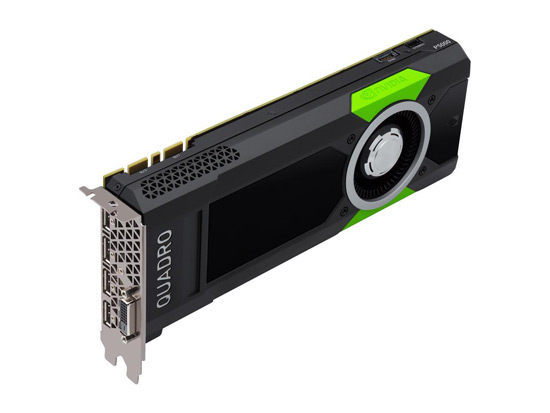
The video memory subsystem has also noticeably improved in the Quadro P5000. Its volume has increased to 16 GB, and the frequency has been brought up to the same as in the P6000, 9 megatransfers per second. Naturally, this required a switch to GDDR5X, but only a 256-bit bus is used. As a result, the increase in memory bandwidth over the M5000 is not as impressive – just 36 percent. Nonetheless, the move from the M5000 to the P5000 is sure to impress CAD / CAM professionals: the cumulative performance improvements are undeniable.
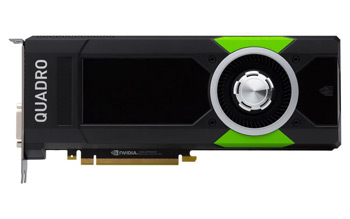

True, energy consumption has also increased along the way. The Quadro P5000 now has a 180-watt thermal pack and uses a single 8-pin connector to connect additional power. In terms of dimensions and design, the Quadro P5000 cooling system is similar to the P6000, but its casing is made not of metal, but of plastic and lacks a transparent window that opens a view of the radiator fins. In addition to the significant performance gains brought by the transfer of professional cards to Pascal architecture, the new Quadro P6000 and P5000 video cards also boast a set of new functionalities.
One of the most important innovations is the appearance of a new display controller in the cards of the Pascal family. While on the surface the new Quadro P6000 and P5000 still carry a DVI port and four DisplayPort outputs, these outputs are now compliant with the DisplayPort 1.4 standard, which is compatible with higher resolutions and frame rates. As a result, while up to four 4K monitors at 60Hz can be connected to the professional cards of the previous generation, the Quadro P6000 and P5000 can work with four 60Hz 5K monitors (5120 × 2880), with four 120- Hertz 4K monitors or even promising 8K monitors (7680 × 4320), such as the recently announced Dell UP3218K.
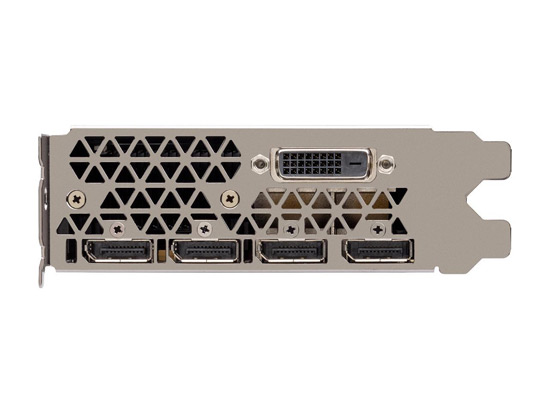
In addition, advancing the ability to handle multi-display configurations, NVIDIA has introduced a new Quadro Sync card for the Quadro P6000 and P5000, which is required to synchronize images from multiple professional graphics cards installed on the same system. The new Quadro Sync II board can handle twice as many Pascal graphics cards – now up to eight. And if we take into account the possibility of connecting up to four monitors to each video card, it turns out that modern NVIDIA technologies allow a total of 32 synchronized monitors to be connected to one system, which can be combined into a single workspace using NVIDIA Mosaic software.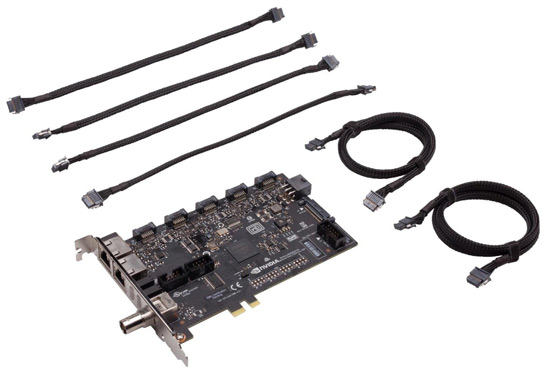
NVIDIA Quadro Sync II
The Simultaneous Multi-Projection (SMP) technology, which is positioned as a step towards virtual reality, also migrated to the professional cards of the Pascal family. It allows calculating the geometry of several projections of the scene from different points in one pass. The main use of this feature in the case of game cards is in support of VR glasses. But in Quadro products, the addition of SMP support may make them a very convenient tool for servicing virtual reality rooms (CAVE).
As a result, it turned out that the new Quadro P6000 and P5000 went far ahead compared to their predecessors. Both new items do not look like a simple planned update of the line, they seriously raise the bar for performance and capabilities of Quadro cards and, in fact, can be considered a revolutionary breakthrough. In all theoretical respects, apart from the amount of memory, the P5000 looks even better than the M6000, which means it’s time for professional users of high-performance workstations to consider upgrading. And we will present even more arguments in its favor in testing, which will be discussed further.
How we tested
We tested professional video cards using as a platform a workstation based on an eight-core Intel Core i7-6900K processor with Broadwell-E architecture, operating at frequencies of 3.2-3.7 GHz. Also, the test platform used a motherboard based on the Intel X99 chipset and 32 GB of high-speed four-channel memory of the DDR4-2666 SDRAM standard. Together with professional video cards belonging to the Pascal generation, flagship cards of the previous generation took part in the comparison, and in addition, in addition to video accelerators of the Quadro family, a GeForce GTX 1080 gaming video card took part in the comparison. Thus, the following equipment was used for the tests:
Processor: Intel Core i7-6900K (Broadwell-E, 8 cores + HT, 3.2-3.7 GHz, 20 MB L3).
CPU cooler: Noctua NH-D15.
Motherboard: ASUS X99-Deluxe (LGA2011-v3, Intel X99).
Memory: 4 × 8 GB DDR4-2666 SDRAM, 15-15-15-35 (2 x Patriot Viper 4 PV416G300C6K).
Video Cards:
NVIDIA Quadro P6000;
NVIDIA Quadro P5000;
NVIDIA Quadro M6000 24 GB;
NVIDIA Quadro M5000;
NVIDIA GeForce GTX 1080.
Disk subsystem: Kingston HyperX Savage 480 GB (SHSS37A / 480G).
PSU: Corsair RM850i (80 Plus Gold, 850W).
The tests were carried out on Windows 7 Professional SP1 x64 and Microsoft Windows 10 Enterprise Build 10240.
The used driver versions:
Intel Chipset Driver 10.1.2.80;
Intel Management Engine Interface Driver 11.0.0.1172;
Intel Turbo Boost Max Driver Version 1.0.1.9;
NVIDIA Quadro Driver Release 376.62.
The video cards were tested at 3840×2160 resolution with Vsync disabled. The choice of 4K resolution is due to the fact that in FullHD resolution flagship professional video cards cannot reveal their potential: performance in this case is limited by the processor power, and the results of faster solutions do not differ from those of weaker video cards. In addition, 4K monitors have become the unspoken standard for high-performance workstations, which the Quadro P6000 and P5000 class offerings are targeting.
Benchmarks specially developed by the Standard Performance Evaluation Corporation (SPEC) were used to benchmark CAD / CAM suites for Autodesk 3ds max, Autodesk Maya, Dassault Systèmes SolidWorks, and PTC Creo. The Cadalyst Systems Benchmark was used to evaluate the speed of work in Autodesk AutoCAD. Rendering speed was measured using tests and projects available on the web, and in addition, we also used popular Futuremark benchmarks to evaluate 3D performance.
Performance in CAD / CAM packages
SPECviewperf 12.1 When testing professional video accelerators, the first thing we always turn to is the synthetic test SPECviewperf, which has taken the place of the industry standard for the primary evaluation of the performance of high-performance workstations during its existence. Simulating a typical load, this test shows the “pure geometric” performance of accelerators when working through OpenGL and DirectX, which is determined by both hardware features and the quality of driver optimization. The principle of operation of this test is to transfer pre-formed traces to the graphics driver – sequences of commands that set the visualization of complex models typical for certain professional applications.
The scripts built into SPECviewperf of the twelfth version we are using recreate the user’s activity in the projection windows in the following professional applications (the names of the corresponding tests are given in brackets): 3ds max 2016 (3dsmax-05), CATIA V6 R2012 (catia-04), Creo 2 (creo- 01), Energy – abstract software package for geological exploration of oil and gas fields (energy-01), Maya 2013 (maya-04), Medical – proprietary software for volumetric rendering of images generated by KT and MRI scanners (medical-01), Showcase 2013 (showcase-01), Siemens NX 8.0 (snx-02), Solidworks 2013 SP1 (sw-03). The result of the tests is the frame rate when working with certain models. The test was carried out at 3840×2160 resolution.
The results given by the new professional video cards of the Pascal generation in SPECviewperf illustrate well the significant leap in performance that took place in the new products compared to the Quadro of the Maxwell 2 family. Previously, with the next generation change, the new sub-flagship positioning video card always delivered speed at the level of the flagship of the previous generation. but today the picture is completely different. Indeed, the Quadro M6000 is defeated not only by the new flagship P6000, but also by the much cheaper new Quadro P5000. Thus, the owners of the top-end professional graphics card of the Maxwell 2 generation can upgrade to the P5000 and at the same time get about a 20 percent increase in performance.
As for the Quadro P6000, we can get such a level of performance from it, which previously could be obtained only in systems using at least a couple of high-performance video accelerators. No joke, but in some tests, the advantage of the P6000 over the M6000 can go up to 80 percent. On average, the Quadro P6000 turns out to be about one and a half times more powerful than its predecessor. Which is quite understandable for NVIDIA’s changed approach to the design of flagship professional video accelerators. Indeed, today the senior Quadro video card is the fastest video card in general, which is based on the most complete version of the senior GPU GP102 and has a higher power even in comparison with the TITAN X.
However, you shouldn’t fully rely on the SPECviewperf results when choosing a graphics accelerator. Still, this benchmark has a synthetic nature, does not take into account the nuances of specific applications and almost does not use complex shader effects, which are gradually beginning to be used for rendering, including professional packages. Therefore, we paid great attention to the study of performance in real applications for 3D modeling and computer-aided design. Autodesk 3ds Max 2015
We carried out testing in one of the most popular 3D modeling packages using the SPEC test, which combines 48 different subtests aimed at comprehensive measurements of modeling speed, interactive graphics and visual effects. The version of this benchmark we are using works with 3ds max 2015 SP4. This is a fairly fresh version of the package, which means that the test uses new DirectX 11 shaders, vector maps, the new Nitrous projection window rendering engine and many other modern dynamic and visual effects. The tests were carried out at 3840×2160 resolution without anti-aliasing and with 8x anti-aliasing.

We refused to test flagship professional video cards in FullHD-resolution, because the four tested accelerators in it give almost the same results. But in 4K mode, which has already become an industry standard for professional engineers, the benefits of using newer and more powerful accelerators are very visible. Here again we can see the overwhelming advantage of the Pascal architecture, which makes the Quadro P5000 a faster card even compared to the Quadro M6000. As for the Quadro P6000, in especially heavy graphics modes with full-screen anti-aliasing, it is able to provide 40% superiority over the M6000 in the speed of work in projection windows.
More detailed data on the speed of the new products under various aspects of the load can be obtained from the following diagrams.
Autodesk AutoCAD 2016 Another popular 3D design application that works through the DirectX interface is AutoCAD. The load on accelerators created by this package is not too great, and even gaming graphics cards do an excellent job in it, but, nevertheless, the difference in performance between solutions of different levels is quite noticeable and is especially clearly manifested in 4K resolution. We used the Cadalyst Systems Benchmark to test performance in AutoCAD.

However, we would not talk about the urgent need to choose high-performance professional accelerators for AutoCAD. As you can see from the graph, the difference in the integrated performance of the flagship professional cards of different generations does not exceed 10 percent. And in past tests, we saw that a comparable level of performance is quite capable of providing mid-range video cards, for example, the Quadro M4000. In other words, AutoCAD should rather be attributed to the number of applications that cannot unleash the potential inherent in professional accelerators of the Pascal generation.
And even more, if we analyze the performance in different display modes of 3D models, it turns out that at least some differences in the speed of the new and old Quadro’s are only in wireframe and realistic modes. Enabling the Hidden or Conceptual visual styles leads to the fact that the performance is limited by the processor, and any of the video cards participating in the test provides the identical rotation speed and modifications of the test models. As for the Wireframe and Realistic modes, the situation is as follows.


Wireframe mode turns out to be the most resource-intensive mode, and in it the Quadro P6000 and P5000 provide a noticeable increase in speed compared to the predecessors of the Maxwell family. In general, despite the fact that Quadro cards are of the same class, but of different generations, have the same number of ROP and texturing units, we again observe the overwhelming advantage of the new products, which in this case is conditioned by their high operating frequencies. PTC Creo Parametric 3.0
Creo CAD is a very popular engineering tool that inherits from the Pro / Engineer package. The SPEC development benchmark we use operates on several different models that reveal different aspects of Creo’s performance, including the new capabilities introduced in version 3 of the software. For example, the test activates Order Independent Transparency, SSAO (Screen Space Ambient Light Obstruction), advanced materials, and bump mapping. The tests were carried out at 3840×2160 resolution.

Although performance was measured in 4K resolution, the Quadro P6000 and P5000 offer a modest performance boost over previous generation Quadro cards. Obviously, the performance of modern flagship graphics cards for engineering applications has increased so significantly that in many cases it even became excessive, and therefore the performance gain from the implementation of the Pascal architecture is not always noticeable in practice. However, it is impossible to deny the fact that the new Quadro P5000 sub-flagship is clearly faster than the Quadro M6000 video card even in such unfavorable cases.
And besides, do not forget that different modes of displaying models in projection windows create a heterogeneous load, and in some cases more powerful professional accelerators can play a much more significant role than shown in the diagram with the integral test result. To see this, let’s take a closer look at the performance of new features in Creo Parametric 3.0.
The strongest advantage of new generation video cards is manifested when the inclusion of complex realistic visual effects: shading and reflections. Also, the removal of invisible lines creates a certain load. In these cases, the older latest generation Quadro cards will offer the best performance levels. Autodesk Maya 2016
The popular 3D editor Maya 2016 is a good example of a professional application using the OpenGL interface. Moreover, the Viewport 2.0 graphics engine in the latest version of Maya has finally been transferred to the modern version of OpenGL 4.x, while the older versions used OpenGL 2.x. That is why it has become important for Maya to use modern professional video cards, the drivers of which fully support this API. For performance testing, we used the SPEC development benchmark, which was adapted to the modern version of Maya and 4K resolution.

The relative performance of Quadro cards across generations does not differ too much, but the new P5000 sub-flagship offers better performance than the M6000 here too. If you analyze the results in more detail, you can get the following picture. The relative speed of the tested video cards looks the same in all display modes. The two new Quadro versions have markedly improved performance over their predecessors, and the new $ 2,500 P5000 is a faster accelerator than the M6000, which still sells in stores for over $ 3,000. Solidworks 2015
SolidWorks is a common CAD software package for automating the work of an industrial enterprise at the stages of design and technological preparation of production. The SPEC benchmark we used for this package uses volumetric models with complexity up to 4.75 million triangles and uses three new display effects RealView, Ambient Occlusion and Shadows in combination with the basic styles: shaded and shaded with visible edges. In addition, the test uses order-independent transparency and full-screen anti-aliasing. The tests were carried out at 3840×2160 resolution with and without full-screen anti-aliasing.
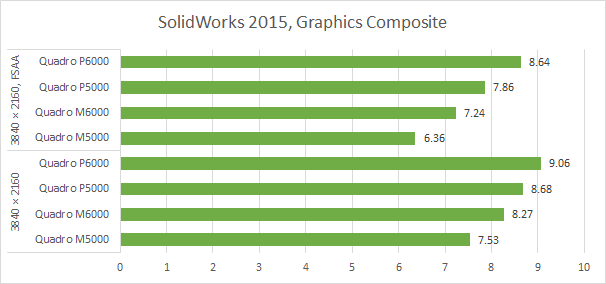
In Solidworks 2015, the advantage of new video cards based on the Pascal architecture is manifested more seriously than in many other cases. Obviously, the support of complex visual styles in this CAD system requires corresponding support from the hardware side. And the new Quadro P6000 and P5000 graphics cards can deliver it with ease. Even if we focus on the mode without full-screen anti-aliasing, the advantage of professional video cards of the Pascal family over the “classmates” of the Maxwell 2 family reaches 10%. However, in complex display modes of 3D models, the difference can be much greater, for example, the inclusion of the Ambient Occlusion (AO) shading model creates a very serious load.
It turns out that if you want to build the most comfortable design environment for yourself in SolidWorks, then a modern professional accelerator is one of the most important components of a workstation. Moreover, according to the last two graphs, it is perfectly clear that investments in this component of the system pay off one hundred percent.
Performance in Adobe Premiere Pro CC 2017
Adobe Premiere Pro is not an engineering 3D modeling and design application, but a nonlinear video editing system. Nevertheless, we decided to include it in our tests, because the use of professional video cards capable of accelerating video processing using shader processors allows us to get a noticeable performance gain in it. To assess the potential of accelerators when processing video using CUDA cores, we measured the final rendering time through the Mercury Playback Engine with GPU acceleration, working with CUDA, of two test tasks.
The first test was conducted with a standard project for evaluating performance in Adobe Premiere Pro, PPBM11. We used the task of rendering an H.264 movie in FullHD resolution. When analyzing the results obtained, it is necessary to take into account that this test project is distinguished by the imposition of a large number of resource-intensive effects on the original video material, which are well accelerated by the GPU. To get a more complete picture of the benchmark results in Adobe Premiere Pro CC 2017 of the Quadro series cards, we have added information about the rendering speed carried out exclusively by the CPU, as well as when using a GeForce GTX 1080 gaming graphics card.
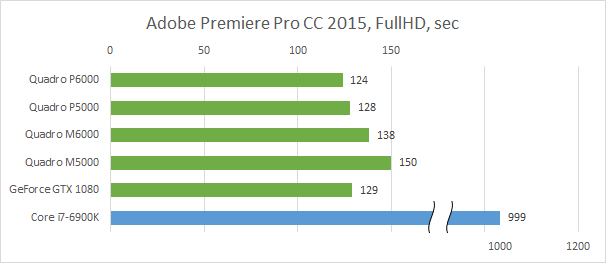
Modern graphics cards with CUDA support are capable of dramatically speeding up video processing. As you can see from the diagram, the flagship eight-core processor Core i7-6900K loses in video rendering speed to the top-level professional Quadro accelerators by almost an order of magnitude. There are noticeable differences in the operating speed of different video cards. Accelerators of the Pascal generation, due to the increase in the number of CUDA-cores, can offer an approximately 10% improvement in results compared to cards of the Maxwell 2 family.
However, it should be borne in mind that the above diagram describes a rather rare “hard” case in which various effects are superimposed on the original video at a very high intensity. Therefore, we included in the tests a second, more realistic “editing” project, in which the rendering is performed in 4K resolution, but the specific density of the effects is much lower.
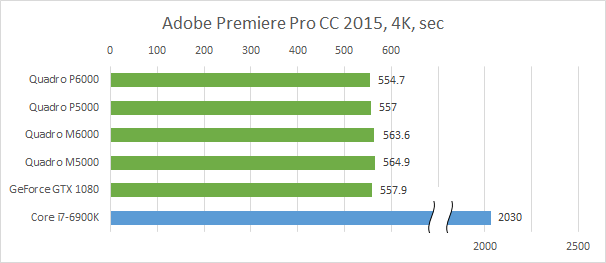
Here rendering on video cards gives only four times the speed up compared to rendering on Core i7-6900K. The difference in speed between different flagship Quadro cards is hardly visible at all. In other words, the urgent need for parallel computing resources in Premiere Pro CC 2017 arises when creating complex effects that are superimposed on each other. Simpler processing may not require the use of flagship video cards with a large number of CUDA processors. But in any case, the Quadro series cards provide a significant increase in speed compared to video processing solely by the processor forces.
Final rendering performance
Today’s professional graphics cards are built on powerful GPUs with hefty computational resources in the form of an array of stream processors. Therefore, in addition to the traditional use to accelerate the display of 3D models in CAD / CAM systems, the Quadro series video cards can be used for final rendering as well. Most renderers rely on 32-bit computing, which means that professional video accelerators can be a good tool for fast and accurate rendering of three-dimensional models, since many popular rendering systems now provide support for CUDA or OpenCL.
All this makes Quadro cards not just graphics accelerators in the traditional sense of this term, but multifunctional combines, which, on the one hand, can make the process of building models and digital projects comfortable, and, on the other hand, provide high speed during their final calculation and visualization. Speaking about the rendering performance of video cards, first of all, we should remember about IRay – NVIDIA’s own physically correct renderer, which it offers for 3ds max and Maya, as well as for Cinema 4D. Unsurprisingly, IRay is deeply optimized for CUDA cards, and is perfectly accelerated by Quadro graphics cards.
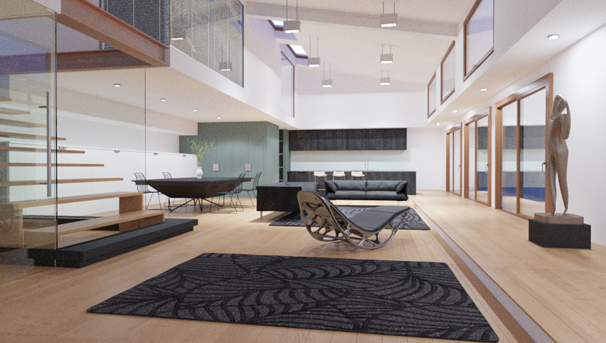
Rendering speed testing was performed in 3ds max 2017 using IRay version 1.3.0-117513. An image of the test scene is shown in the illustration above, it is composed of 494 objects and includes 18 lights. When building the final image at a resolution of 1024 × 579, 1000 iterations are made.
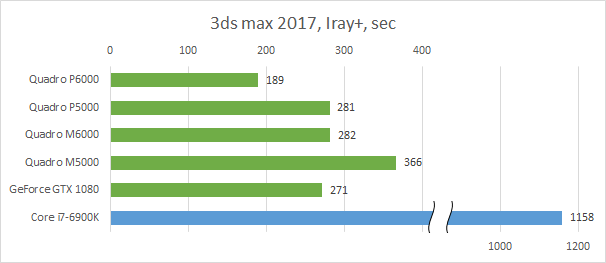
Rendering in NVIDIA IRay using video cards works much faster than on an eight-core CPU. The superiority of video cards of the Pascal generation over their predecessors is also clearly visible. The presented results speak for themselves, but it should be added that such a high processing speed, which can be provided by NVIDIA P6000 and P5000, makes it easy to use these video cards even in interactive rendering mode. The ability to render using video cards with support for CUDA and OpenCL is also available in the popular Blender 2.78a software package for creating three-dimensional computer graphics. For performance tests in this case, we used the standard Blender Cycles Benchmark scene, which was rendered at 1920 × 1080.

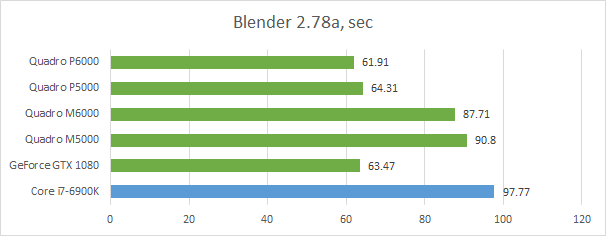
Here the gap in rendering speed on Quadro video cards and an eight-core processor turned out to be not so significant. However, the increase in computational performance that occurred with the transition of the GPU to the Pascal architecture cannot be denied. The advantage of new professional video cards over their predecessors reaches one and a half times the size. To test the performance of ray traced rendering using the Arion renderer, we used the special RandomControl Arion Render Benchmark.
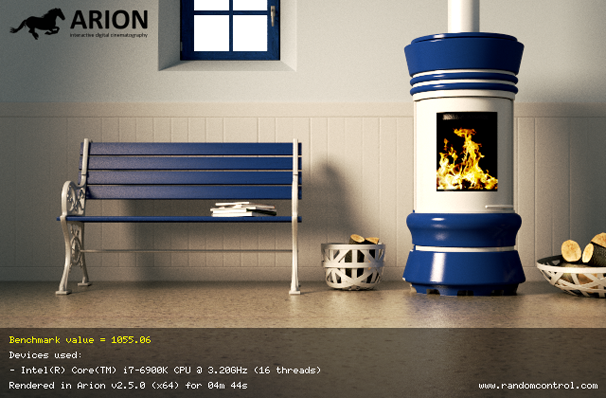
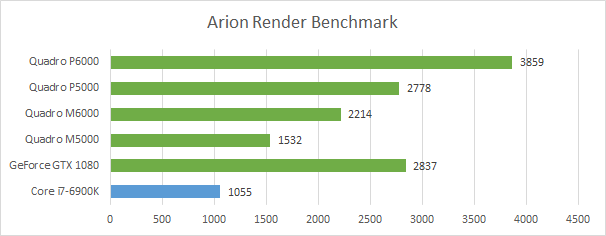
The advantage of the new Quadro is once again quite impressive. With the increase in the number of CUDA processors and the increase in clock speeds, professional cards of the Pascal generation have achieved more than impressive peak performance characteristics. They are reflected in performance in real tasks, and a striking example of the improvements that have occurred can be almost a twofold increase in the speed of rendering using the ray tracing method.
For testing purposes, we also used another engine for constructing photorealistic images using the ray tracing method, using the power of graphics cards through the OpenCL universal programming interface – LuxRender. LuxRender simulates the propagation of light in reality using special algorithms and exists in versions for the following specialized software: Blender, 3dsmax, SketchUp, C4D, XSI, Poser, etc. complexity.
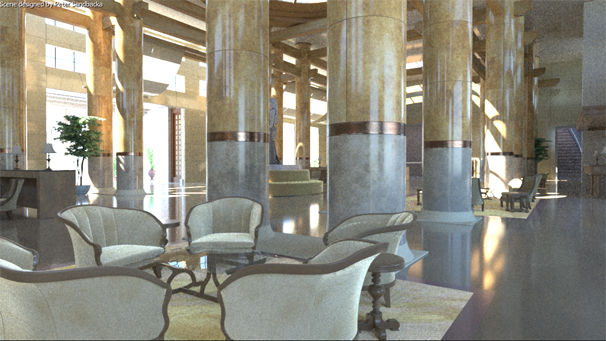
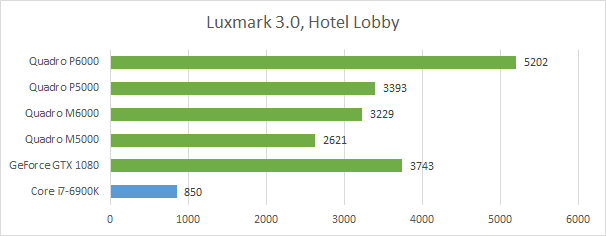
The advantage of the Pascal graphics architecture is clearly visible here as well. The Quadro P5000 renders noticeably faster than the Quadro M6000, and its superiority over the eight-core Core i7-6900K processor reaches many times the size. As for the Quadro P6000, this record-breaking video card can boast a result that is twice as high as that of the Quadro M6000, which once again points to the significant progress that has occurred with the introduction of the Pascal architecture into professional graphics accelerators.
Performance in gaming 3D and VR
This time NVIDIA has got some very cool professional cards. The fact is that usually the flagship accelerators of the Quadro series were superior to gaming video cards only in CAD / CAM packages, where specific driver optimizations played a role. In terms of absolute performance characteristics, symmetric versions of GeForce were faster than Quadro due to higher operating frequencies. But with the arrival of the Pascal-generation GPU, the situation has changed. Today Quadro P6000 is the fastest graphics card without any reservations, it outperforms GeForce GTX 1080 and TITAN X even as a gaming accelerator. To be convinced of this, just look at the results we got in the popular Futuremark 3DMark benchmark.
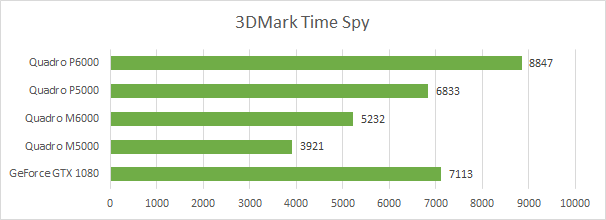
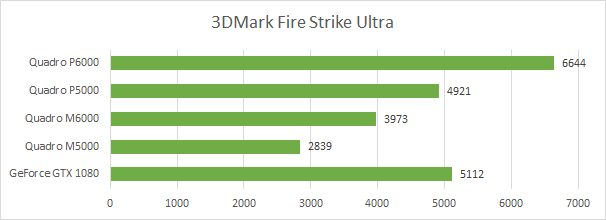
Quite impressive results are shown by the Quadro P6000 and P5000 and in the Futuremark VRMark test, which measures the speed of systems when working with virtual reality systems. This test produces two metrics. VRMark Orange Room shows the GPU power is sufficient to work with HTC Vive and Oculus Rift, and VRMark Blue Room evaluates the ability of video cards to work with future generations of VR headsets that will work at 5K resolution.
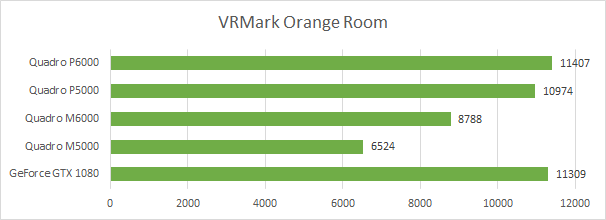
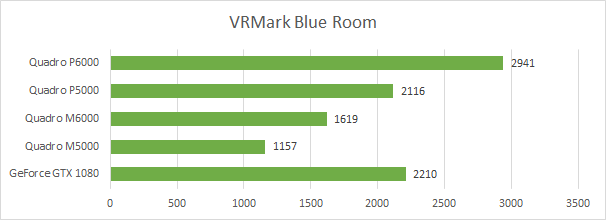
VRMark Orange Room shows that the power of the Quadro P6000 and P5000 is more than enough to handle modern VR headsets. For full compatibility with HTC Vive and Oculus Rift, performance indicators at the level of five thousand points are enough, and professional cards of the new generation give twice the result.
But according to VRMark Blue Room, when working with promising VR-helmets, difficulties may arise. Even the Quadro P6000 falls short of optimal results. However, at the current level of development of graphic architectures, achieving the target of five thousand points can only be achieved using multi-GPU configurations. At the same time, the test clearly shows that the Quadro P6000 and P5000 with Simultaneous Multi-Projection technology are much better suited for working with virtual reality than video cards based on previous generation GPUs.
Energy consumption
The new Pascal generation GPUs have an increased number of stream processors and much higher operating frequencies compared to Maxwell 2. However, the thermal package of the Quadro P6000 remained at the same level as that of the M6000, and the P5000, according to the passport specifications, became only 20 percent more gluttonous than its predecessor. NVIDIA claims that the transition to 16nm technology allowed to do without significant changes in heat dissipation and power consumption, which significantly raised energy efficiency. In theory, all this should allow the possibility of a seamless upgrade of existing workstations with new Quadro cards, and such an upgrade should not require replacement of cases, cooling systems or power supplies.
To check, let’s take a look at the actual power consumption of complete systems (without a monitor) equipped with various professional graphics cards. The new Corsair RM850i digital power supply we used in our test system allows us to monitor the consumed and output electrical power, which we used for practical measurements. That is, the following graph shows the total system consumption, measured “after” the power supply, and is the sum of the power consumption of all components involved in the system. The efficiency of the power supply itself is not taken into account in this case. The load for determining the peak consumption was created by FurMark 1.18.2, run in the “Burn” mode in a window with a resolution of 1280×720. This type of load is good because, like most professional applications,

The values obtained in practice for the power consumption of video cards under load fully correspond to the declared characteristics. The Quadro P6000 is not at all more gluttonous than the previous flagship, the M6000, and the consumption of the Quadro P5000 is higher than that of its predecessor, only by a little over 20 watts. Thus, the energy efficiency of professional accelerators of the Pascal generation has really reached a new level and the increase in performance has occurred without a noticeable increase in energy appetites.
In addition, while testing the new Quadro under load in FurMark, we were able to verify the good performance of the cooling systems used on the cards. The maximum GPU temperature of the Quadro P6000 did not exceed 84 degrees, while the maximum heating of the GPU in the Quadro P5000 was only 81 degrees. When you go beyond these target temperatures, the video cards slightly lower the GPU frequency. In both cases, the centrifugal fan in the cooling systems did not exceed 2500 rpm, which is approximately 60 percent of its maximum speed. In such conditions, it operates with a fairly low noise level and does not go beyond the boundaries of acoustic comfort.
conclusions
The Pascal architecture is a huge step forward for accelerators of all classes. The transition to 16nm technological process allowed NVIDIA not only to increase computing power by adding additional CUDA cores to GPUs, but also made it possible to seriously raise clock frequencies. The introduction of the new GDDR5X with 16n prefetch increased the memory bandwidth. As a result, video cards built on GPUs of the Pascal generation, in terms of performance, are noticeably superior to their predecessors.
Professional accelerators for high-performance workstations are no exception. So far, NVIDIA has presented only two senior cards of the new generation Quadro line, Quadro P6000 and P5000, but it is clear from them that the arrival of the Pascal architecture marks not another evolutionary update of the line, but a real revolutionary breakthrough. The fact is that thanks to the transfer of the Quadro accelerator series to new graphics processors and faster GDDR5X memory, NVIDIA has increased its computing potential much more seriously than it has ever happened before. Plus, the company has taken two more important steps. First, it has increased the amount of video memory, giving new professional video cards the ability to work at the highest resolutions and with ultra-complex models. Secondly, the company also changed the general approach to the characteristics of Quadro: now in this series will be available not only high-speed and optimized solutions for professional use, but video cards with the highest possible performance at the moment. An excellent example of such a strategy is the Quadro P6000: this video card now not only takes the place of the most powerful professional video accelerator with drivers optimized for CAD / CAM systems, it is also the fastest video card in general.
All this is reflected in the level of performance that the tested novelties demonstrate in their typical applications: in computer-aided design and 3D modeling systems. The superiority of the Quadro P6000 and P5000 over the solutions of the Maxwell 2 generation in many cases reaches one and a half or even two times the size. As a result, even the new sub-flagship Quadro P5000 turns out to be noticeably faster than the older video card of the previous generation, the M6000.
These dramatic advances in performance make the new Quadro Px000 cards more than just a great choice for today’s workstations. Quite frankly, the same could be said about the previous generation Quadro Mx000. After all, it did an excellent job of accelerating the display of models in CAD / CAM systems, even in 4K resolutions. But now Quadro cards are claiming more: they may well take the place of multi-functional combine harvesters for professionals. Indeed, in addition to providing a comfortable working environment, they are able to provide specialists with significant computing resources, which are easy to use for the final visualization and rendering of finished projects. In other words,
To what has been said, we must add that the highest performance of the Quadro P6000 and P5000 video cards is far from being an extra reserve for the near future. The power of these solutions will probably be enough to speed up work in the future transition to ultra-high resolutions (5K and 8K), as well as when working with increasingly popular virtual reality systems, especially for which new hardware support has appeared.
PNY Technologies is the official manufacturer and supplier of NVIDIA Quadro professional video cards in Russia.





